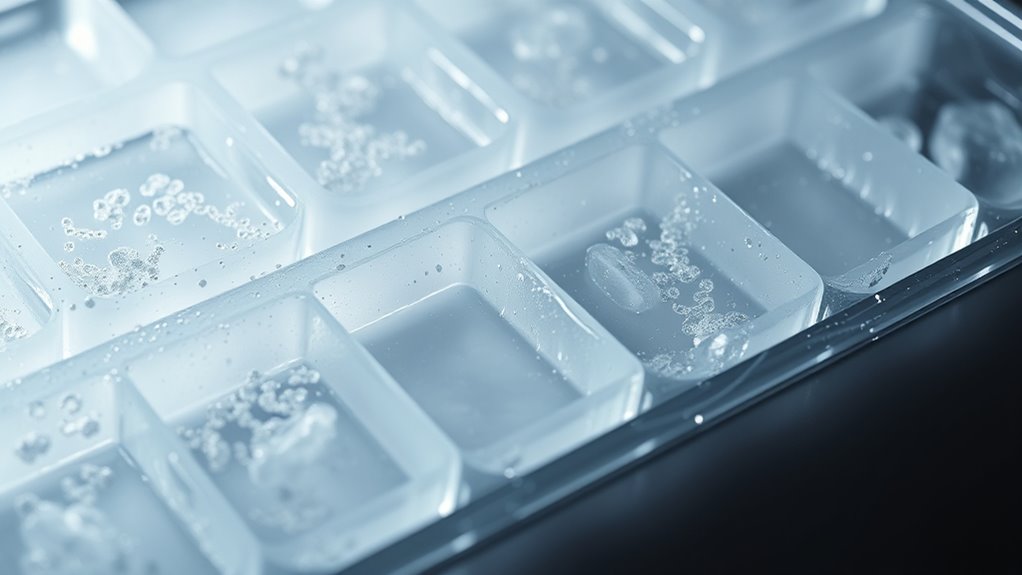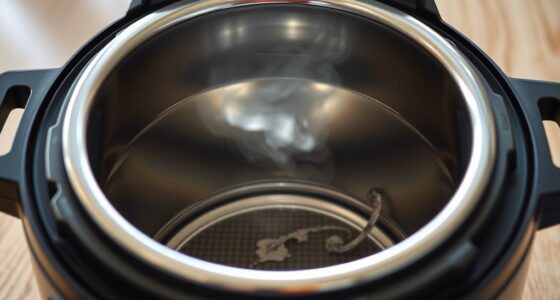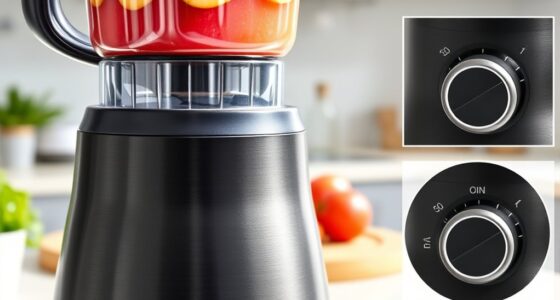Your ice maker can harbor more bacteria than you think, thriving in its moist, cool environment. Microorganisms like E. coli, Salmonella, molds, and yeasts can cling to surfaces, especially if you neglect regular cleaning. These bacteria pose health risks, causing stomach issues or infections. Recognizing signs like slimy ice or strange odors is key. Proper sanitation methods can eliminate these germs. Keep going to discover simple steps to keep your ice maker safe and bacteria-free.
Key Takeaways
- Ice makers can harbor bacteria like E. coli, Salmonella, and molds due to constant moisture and cool temperatures.
- Residual water and damp internal parts create ideal conditions for microbial growth.
- Poor cleaning practices can lead to significant bacterial buildup, contaminating ice.
- Signs of contamination include foul odors, cloudiness, slimy ice, and unusual melting patterns.
- Regular sanitization with proper cleaning reduces bacteria and ensures safe, clean ice for consumption.
How Bacteria Finds Its Hidden Home in Your Ice Maker
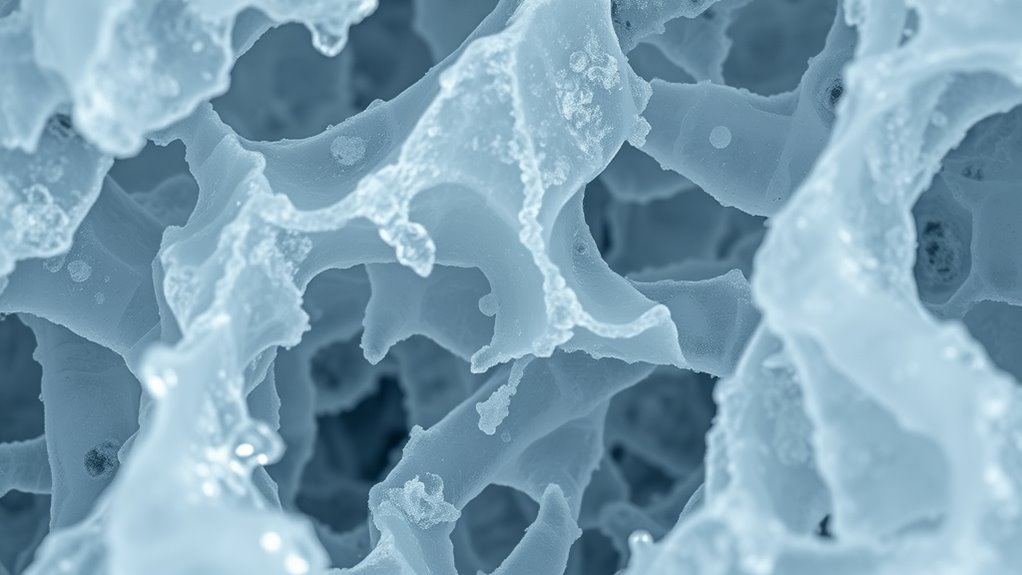
Bacteria often find their hidden home in your ice maker because it provides a moist, cool environment ideal for their survival. When you leave the door open or neglect regular cleaning, water droplets cling to surfaces, creating perfect havens for microbes. Residual moisture from previous ice batches can harbor bacteria, especially if you don’t empty and clean the tray regularly. The internal components, like water lines and reservoirs, remain damp, allowing bacteria to cling and multiply unnoticed. Bacteria thrive in this environment because it’s consistently cold, preventing their destruction. Over time, these microorganisms can proliferate, especially if you don’t maintain proper hygiene. Without regular cleaning, your ice maker becomes a hidden, persistent source of bacteria that can pose health risks. Additionally, automation in cleaning processes can help reduce bacteria buildup by ensuring thorough sanitation without manual effort. Implementing routine maintenance and following manufacturer guidelines can further enhance hygiene and protect your health. Incorporating advanced cleaning technology, such as UV sterilization, can further eliminate bacteria and improve overall appliance safety. In fact, recent machine learning algorithms are being used to develop smarter cleaning cycles that adapt to usage patterns, further reducing microbial growth.
The Types of Microorganisms That Thrive in Ice Machines
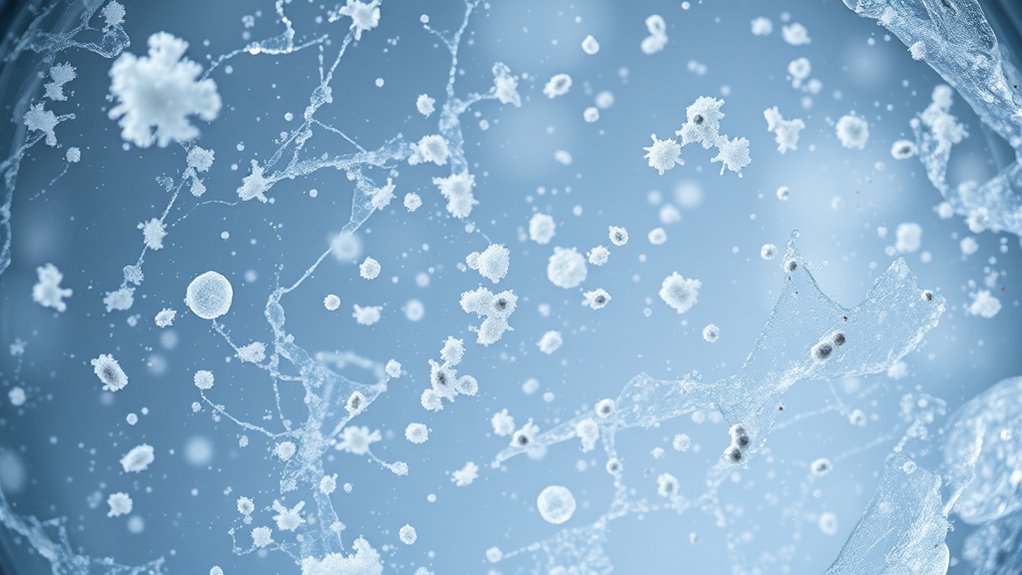
Many microorganisms can thrive in ice machines, especially when conditions favor their growth. Bacteria such as coliforms, including E. coli, can survive in moist, cool environments like ice makers. You might also find Pseudomonas, which prefer damp surfaces and can cause spoilage or infections. Fungi like molds and yeasts can grow on the surfaces if cleaning is infrequent, creating slimy or fuzzy patches. Additionally, some opportunistic pathogens, like Salmonella, may be present if contamination occurs. These microorganisms adapt well to the cold, damp environment, making ice machines a perfect breeding ground. Without proper cleaning, bacteria and fungi multiply rapidly, increasing the risk of consuming contaminated ice. Recognizing microbial growth and understanding their survival mechanisms highlight the importance of regular maintenance. Proper sanitation practices are essential to prevent the spread of microorganisms that can cause illness and ensure safe ice production. Regular cleaning and disinfecting can significantly reduce microbial buildup, lowering health risks associated with contaminated ice. Implementing preventative measures like routine inspections and maintenance can further reduce microbial presence and promote safety. Regularly checking water quality can also help prevent microbial growth in your ice maker.
The Risks of Consuming Contaminated Ice
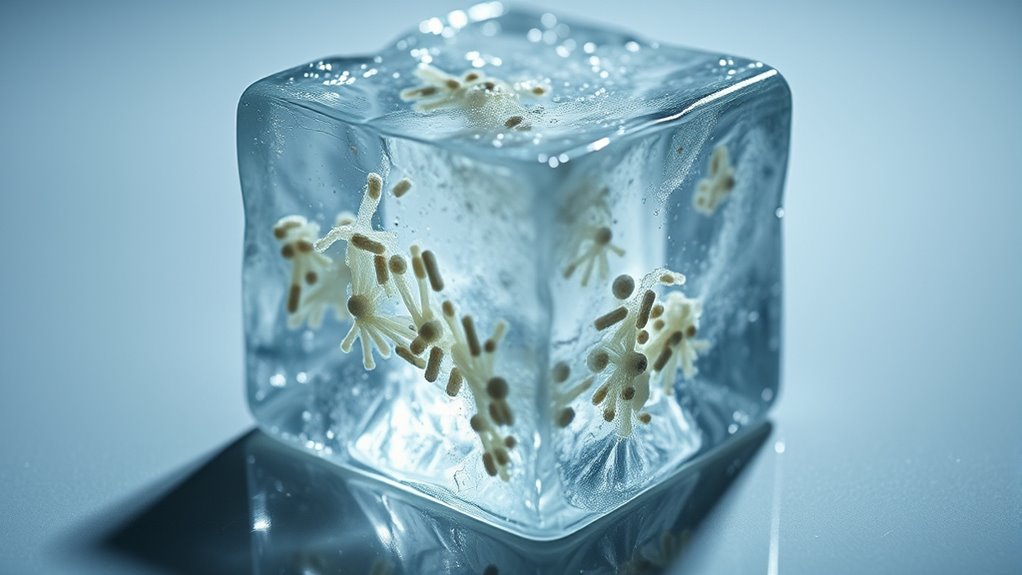
Consuming contaminated ice can pose serious health risks, especially if harmful microorganisms like E. coli or Salmonella are present. When you ingest ice contaminated with bacteria, you risk developing illnesses such as stomach cramps, diarrhea, vomiting, and fever. These infections can be particularly dangerous for children, the elderly, and those with weakened immune systems. Bacteria from your ice maker can cause food poisoning, leading to dehydration and other complications if not treated promptly. Even small amounts of contaminated ice can introduce pathogens into your body. Proper filter maintenance and regular cleaning of your ice maker are essential to prevent bacterial growth. Bacteria thrive in moist, dark environments like ice makers, making it easy for harmful microbes to survive and contaminate your drinks. Regular cleaning routines help eliminate these bacteria and reduce the risk of illness. Avoiding contaminated ice protects your health and prevents potential illnesses.
Signs That Your Ice Maker Needs a Deep Clean
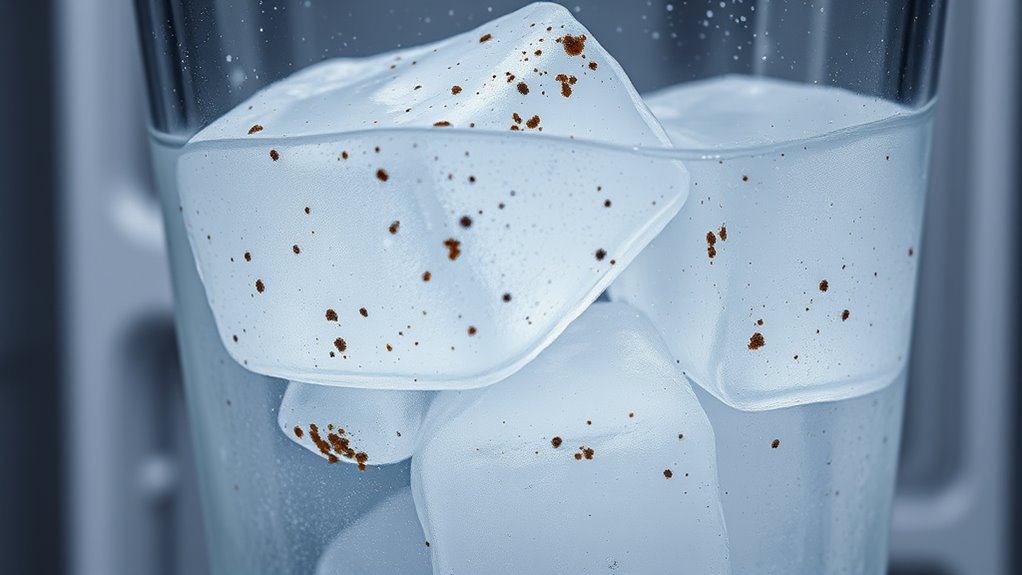
If you notice your ice has a strange odor, cloudiness, or a slimy texture, it’s a clear sign that your ice maker needs a deep clean. Cloudy ice indicates buildup of mineral deposits or bacteria, while a foul smell suggests bacterial growth. Slimy or sticky ice points to mold or mold spores thriving inside the machine. Additionally, if your ice cubes frequently clump together or melt faster than usual, it’s a sign that bacteria or mold may be contaminating the system. Persistent ice quality issues, even after routine cleaning, can also signal hidden mold or bacteria lurking inside. Recognizing these signs early helps you prevent health risks and ensures your ice remains safe and fresh. Ignoring these symptoms can lead to bigger contamination problems. Regular maintenance and thorough cleaning can also help prevent bacterial growth and improve overall ice quality. Incorporating advanced cleaning techniques as recommended by experts can further ensure your ice maker stays sanitary. Proper use of cleaning tools can help eliminate residues that foster microbial development. For optimal results, consider using specialized filter replacements to maintain cleanliness and reduce microbial buildup inside your ice maker.
Effective Steps to Sanitize Your Ice Maker Safely
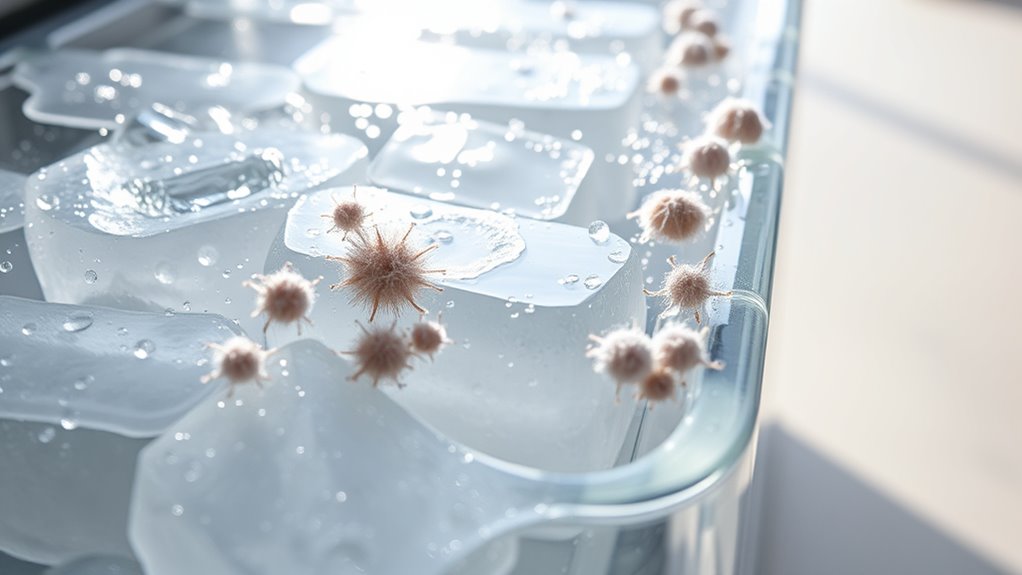
To guarantee your ice maker is free from bacteria and mold, you need to sanitize it thoroughly and safely. Start by unplugging the unit and removing all removable parts, like ice trays and filters. Wash these parts with warm water and mild soap, then rinse well. Next, prepare a sanitizing solution using one tablespoon of unscented bleach in a gallon of water. Use a clean cloth or sponge to wipe down the interior surfaces, paying attention to corners and seals. Let the solution sit for 5-10 minutes, then rinse thoroughly with clean water. It is also helpful to select the appropriate essential oils for sanitation that complements your hand and personal style. Regular sanitizing helps prevent bacteria buildup and keeps your ice fresh and safe to consume. Additionally, incorporating proper cleaning schedules can ensure ongoing safety and hygiene of your appliance, especially considering the air purifier features and technology that can contribute to overall indoor cleanliness.
Frequently Asked Questions
Can Bacteria in Ice Makers Cause Serious Illnesses?
Bacteria in ice makers can potentially cause serious illnesses if ingested, especially for vulnerable groups like the elderly, young children, or those with weakened immune systems. Pathogens such as Salmonella or E. coli may thrive in moist environments, leading to infections. To stay safe, regularly clean your ice maker and handle ice with clean hands. Keeping your appliance sanitary minimizes health risks and guarantees your ice remains safe to consume.
How Often Should I Clean My Ice Maker for Safety?
Imagine your ice maker as a garden that needs regular tending. To keep bacteria at bay and guarantee safe, clean ice, you should clean it at least once every 3 to 6 months. If it’s used frequently or you notice any buildup, cleaning every month is wise. Regular maintenance acts like a shield, protecting you from unseen threats lurking within. Stay vigilant, and your ice will remain fresh and safe to enjoy.
Are There Specific Brands More Prone to Bacterial Buildup?
You wonder if certain brands are more prone to bacterial buildup. While some cheaper models might have less effective cleaning features or harder-to-reach parts, bacteria can grow in any ice maker if not cleaned regularly. Focus on maintaining good hygiene regardless of brand by cleaning your ice maker every few weeks, using proper disinfectants. No brand is immune, so consistent cleaning is your best defense against bacteria.
Does Using Filtered Water Reduce Bacteria in Ice?
Using filtered water can substantially reduce bacteria in your ice because it removes contaminants, improves taste, and decreases mineral buildup. Filtering your water helps eliminate bacteria, viruses, and other impurities before they even reach your ice maker. By choosing filtered water, you’re not just enhancing ice clarity and flavor, but also creating a safer environment for your family. It’s a simple step that makes a big difference in maintaining cleaner, healthier ice.
What Are the Long-Term Health Effects of Consuming Contaminated Ice?
Consuming contaminated ice over time can expose you to harmful bacteria and pathogens, increasing your risk of infections, stomach issues, and other health problems. Repeated ingestion may weaken your immune system and lead to more serious illnesses, especially if you have underlying health conditions. To protect yourself, always verify your ice is clean, use filtered water, and regularly clean your ice maker. Staying vigilant helps prevent long-term health complications.
Conclusion
So, as tempting as it is to trust your ice maker, remember it’s a secret bacteria haven. You’d think ice would be the cleanest part of your drink, but nope—those germs are just chilling there, waiting to surprise you. Regular cleaning might not be glamorous, but it’s your best bet against an unexpected bacteria party. Ironically, the last thing you want is to enjoy a cold drink and end up with an unwanted microbial guest.
